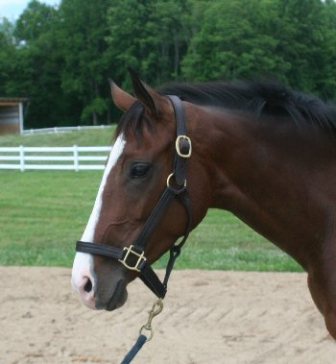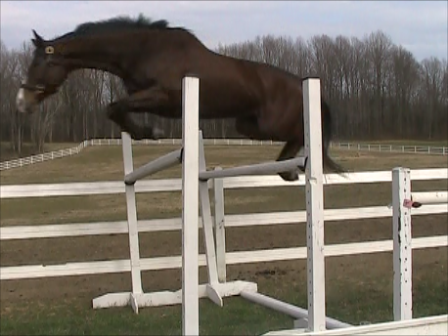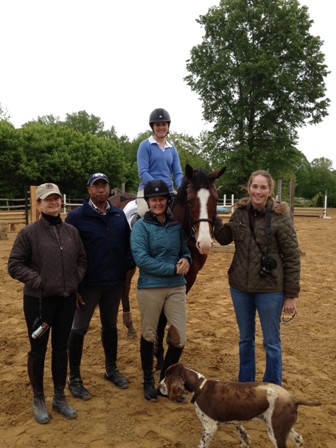Today, I bring you the story of the up-and-coming off track Thoroughbred-turned show horse Constant Star, as told to me by Kimberly Clark:
In December 2009, Constant Star was a 2-year-old filly who had two unplaced efforts at Charles Town and Laurel Park and meager earnings of $280. As the promise of having a successful career on the racetrack quickly faded, her future became uncertain.
In hopes Constant Star could find a new purpose, her trainer contacted a Maryland-based organization called Thoroughbred Placement Resources to try and find her a home. The filly was eventually adopted by an older woman who had considerable experience with retired racehorses and called Constant Star her "dream horse.”
While Star was talented, athletic, and precocious, her spirited temperament proved to be more than her new owner could handle. The mare was loved and cared for, but her training wasn't going well. So, in the fall of 2011, two years after the adoption, her owner contacted TPR again and asked for help in re-homing Star.
Space is always limited at Leighton Farm near Upper Marlboro, Md., the training center for TPR. The average wait list to get into the farm is about 30 horses. Many will never get in and sadly, some will never have a future.
“It's always difficult to decide which horses will come here,” said Kimberly Clark, president and founder of TPR, who accepted Constant Star back into the program due to her special qualities. “Normally it comes down to two classes: horses that can be sold to support TPR since there is no retirement program for Maryland's racehorses, and horses that have special needs. A horse with a training problem is a priority here because they are on the wrong path. Oftentimes horses like that eventually end up in a kill pen as they are passed from one person to another.”
TPR is one of the many organizations
that have been developed in recent years to assist Thoroughbreds in
finding appropriate and responsible placement after their time on the
race track has ended. One thing that sets the organization apart from other
placement programs is that it is a vehicle for Thoroughbred horsemen to
take responsibility for their own retiring racehorses.
“What is happening is a cooperative effort on the backstretch by owners
and trainers to get their horses into the best possible hands," said Clark. "Too many
times the responsibility falls on people outside the industry, when it
should be borne primarily by us, with their support."
The horses at Leighton Farm enter a training program developed by Clark and Elizabeth Madlener, a grand prix dressage coach, judge, and rider. The program takes advantage of the training and skills a racehorse already possesses.
“Most of the time in ‘problem horses,’ it’s not the horse that is the problem,” explained Clark, who began training Constant Star to jump at the end of last year. “It's the handling and training (or lack thereof) that is creating the issues. In Star's case, it wasn't long before I knew she was very special. She just needed a job and routine on which she could depend."

Constant Star, all photos courtesy of Thoroughbred Placement Resources
Constant Star's pedigree is not all too different from this year's Kentucky Derby Presented by Yum! Brands (gr. I) and Preakness (gr. I) winner I’ll Have Another. The little mare, sired by
Fantasticat and out of the Diazo mare Risentothestars, was born in Maryland without the
intention of ever seeing a jump. Like I’ll Have Another, Constant Star has Northern Dancer on
both the sire and dam side of her pedigree. They also share Alydar and
Raise A Native as distant relatives.
“I was intrigued by Constant Star not long after I started putting her to the jumps," said Clark. "I decided to take her to David Loman, my hunter/jumper trainer and he agreed this was a special mare. By December, I was also taking her to work with (Olympic rider-turned-trainer) Jim Wofford.”
Star competed in jumper and dressage shows over the next few months and won both classes at her first dressage show. With each new outing, she rose to the challenge and continued to progress.

Constant Star, enjoying a free jump
Due to Star’s advancement, Clark decided to nominate the filly to the Breeder's Bridge Contest and the mare was selected out of 140 entries.
The contest, which is the brain child of John and Beezie Madden, has a goal of cultivating and promoting North American-bred sport horses, including ex-racehorses looking for new careers.
In order to enter the contest, one must submit a video and written description of the nominated horse. Selected horses receive three months of free training and board at John Madden Sales in Cazenovia, N.Y., where they will be ridden and brought along by up-and-coming grand prix rider Callie Schott.
“The Maddens feel we have some spectacular breeders here in North America and there's no reason the next top grand prix horse can't come from one of them,” said Clark.

Pictured left to right - Kimberly Clark (owner), David Loman, Susanna Baskin, Callie Schott, Constant Star, Erin Root, and Maddie the dog.
The Maddens train, sell, and compete prominent equestrian
athletes in the sport of show jumping. Accomplishments include two team
Olympic Gold medals and an individual Bronze, as well as World
Equestrian Games individual silver. They have also conditioned and been
instrumental in the development of many current top riders and trainers.
“Star's selection as one of the winners is not just an opportunity to show her amazing talent and potential,” said Clark. “It enables Star to represent the incredible potential of ‘Made in America’ horses and emphasizes the athleticism, intelligence, and work ethic of the Thoroughbred.”
Clark said many of the negative discussions she overheard before the contest and after the results were announced illustrated how many people underestimate the talent and athleticism of the Thoroughbred. “I don't understand this, considering all of the successful Thoroughbreds involved in equestrian sports,” she said.
“I know of no other breed that is present and successful in as wide a variety of equine disciplines," she continued. "Thoroughbreds participate in endurance riding, show jumping, hunters, fox hunting, eventing, dressage, polo, stage coach racing, regular racing, trail/pleasure, and more. There are countless registries that seek Thoroughbred blood in their breeds, including most Warmbloods.
“In my experience many of the problems associated with Thoroughbreds are due to misinformation and lack of understanding of the breed. In the case of the off track Thoroughbred (OTTB), its lack of knowledge of their prior training and handling−basically their foundation is the cause of most of the problems encountered by sport and pleasure owners."
Clark noted how Constant Star’s off-the-track achievements are unusual for a Maryland-based Thoroughbred since the state does not have a retirement program.
Thoroughbred Placement Resources not only facilitates the placement of an average 150 horses per year, most which are Maryland-based racehorses, but also assists if the placement isn't working out.
“In essence this organization was able to catch this ‘falling star,’ ” said Clark of Constant Star. “Horses that leave the track are filled with potential and have so much to offer the show and pleasure world. As the Maddens are illustrating through this contest, you don't have to look overseas to find your next star; he or she is likely waiting for you on a farm located here in the United States or even at your nearby racetrack.”
“You just never know where your next Olympic horse will come from," added Beezie Madden, a two-time Olympic Gold Medalist. "John
and I believe in the greatness of the American Thoroughbred and the
breeders here in North America. I applaud all the owners and trainers
who have been involved in Constant Star’s short life. They recognized a
good horse and she was placed in the right situations when her first
career didn’t materialize. She was given the chance to excel at
something else."
Added John Madden: “It was important to Beezie and I to do something to showcase and
support the strength of pedigrees we have here at home. In the sport of show jumping many athletes forego sourcing
prospects here in North America as there is a greater volume of horses
in a more condensed area in Europe.”
********************************************************************************************
I would love to hear your thoughts on Constant Star's story...What do you think we can do to raise more awareness for the value and potential of ex-racehorses on the show circuit?

Constant Star




